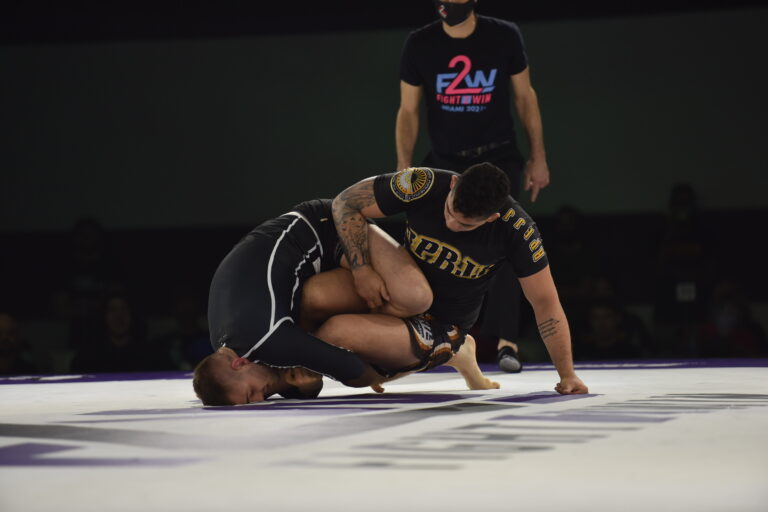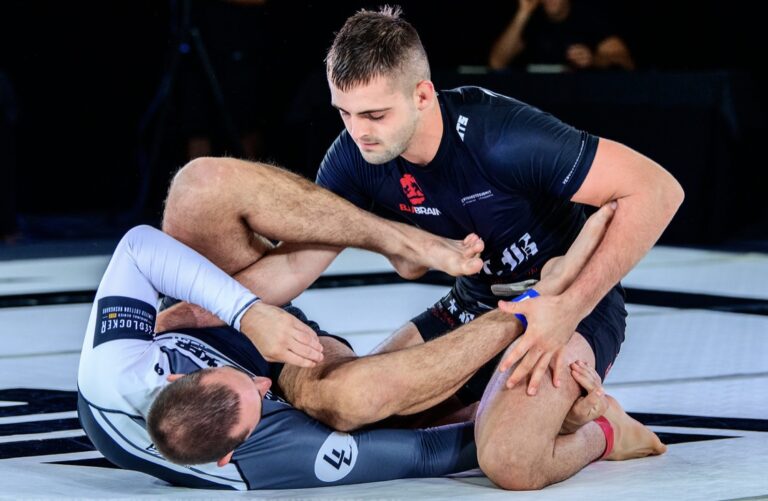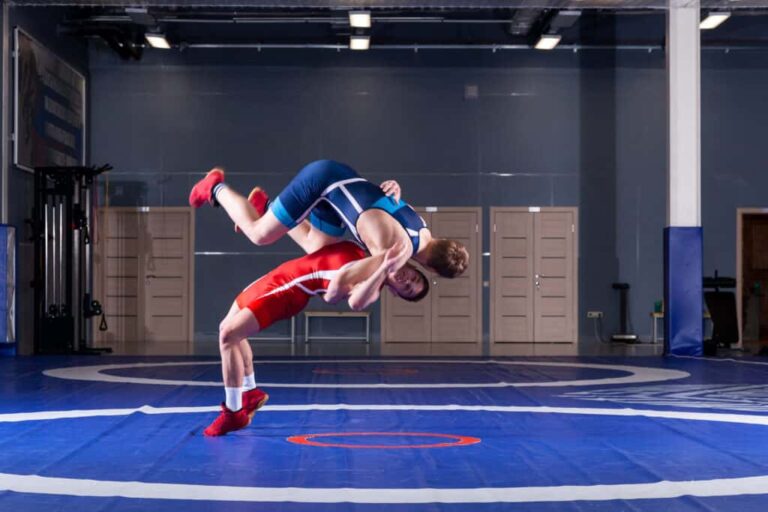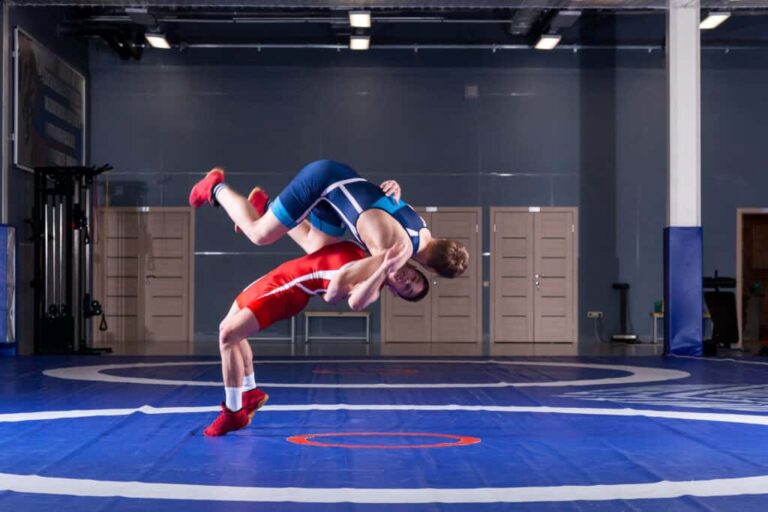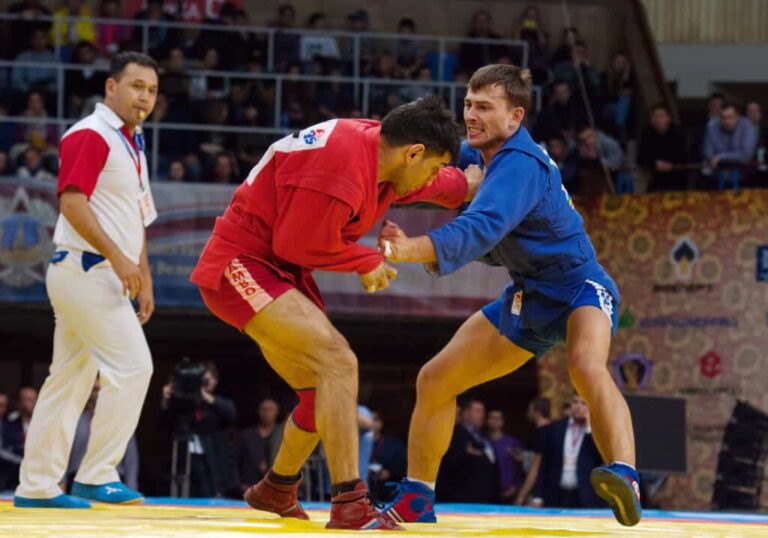What Are the Weight Classes for High School Wrestling?

High school wrestling weight classes are divided into categories based on the weight of the competitor at the time of the competition. In addition, wrestling weight classes are also in different categories based on gender.
The weight classes for high school wrestling begin at 106 lbs and top out at 285 lbs for boys, and range from 101 lbs to 235 lbs for girls. In total, there are 14 weight divisions for high school wrestlers as opposed to the 10 typically featured at the Olympic and Collegiate levels.
This article will explain:
- The 14 different weight classes featured in high school wrestling.
- The reasons for having separate weight classes in high school wrestling and expand on the rationale behind it.
- A few general tips, factors, and suggestions for how a high school wrestler can determine which weight class they are best suited to compete in.
How Many Weight Classes For High School Wrestling
While a few states do feature modified weight classes, creating an exception to the standard high school wrestling weight categories, the 14 weight classes listed below are almost universal for high school wrestling competitions nationwide.
High School Wrestling Weight Classes Male and Female
The weight classes for high school wrestling according to the NFHS (National Federation of High Schools) and the CIF (California Interscholastic Federation) are as follows:
| Boys | Girls |
| 106lbs (48kg) | 101lbs (45.8kg) |
| 113lbs (51.3kg) | 106lbs (48kg) |
| 120lbs (54.4kg) | 111lbs (50.3kg) |
| 126lbs (57.2kg) | 116lbs (52.6kg) |
| 132lbs (59.9kg) | 121lbs (54.9kg) |
| 138lbs (62.6kg) | 126lbs (57.2kg) |
| 145lbs (65.8kg) | 131lbs (59.4kg) |
| 152lbs (68.9kg) | 137lbs (62.1kg) |
| 160lbs (72.6kg) | 143lbs (64.9kg) |
| 170lbs (77.1kg) | 150lbs (68kg) |
| 182lbs (82.6kg) | 160lbs (72.6kg) |
| 195lbs (88.5kg) | 170lbs (77.1kg) |
| 220lbs (99.8kg) | 189lbs (85.7kg) |
| 285lbs (129.3kg) | 235lbs (106.6kg) |
Those familiar with international, Olympic, or collegiate wrestling may notice that there are more weight classes in high school wrestling than there are in the formerly mentioned three, which typically only feature 10 divisions instead of 14.
The weight classes in high school wrestling tend to be very precise, with very little space between them. At times the differential between weight divisions in high school wrestling is only a matter of six pounds. However, there is a well-thought-out and justifiable reason for the insertion of such specific weight classes, which we will now elaborate on further.
The Importance Of High School Wrestling Weight Classes
There are many reasons why weight classes are so strictly adhered to in wrestling competitions.
Assuming that two wrestlers possess the same level of skill and ability, the athlete who weighs more and has more mass will have a significant advantage and would be the favorite to win. This is because a significantly heavier opponent will be able to use their bodyweight like a sandbag to score/avoid takedowns against their lighter counterpart.
Because of this, if a wrestler fails to make the required weight necessary to enter their respective weight class at the time of their scheduled weigh-in, they are disallowed from competing.
Ensuring every wrestler makes weight before competition keeps everything fair between the athletes and allows the wrestlers to showcase their skills and abilities without being placed at a physical disadvantage that cannot necessarily be overcome with technique alone.
Weight classes also reduce the likelihood of an injury occurring as the matches are much fairer and more closely contested. High school wrestling features 14 weight classes, as opposed to the 10 most commonly found in the adult ranks so that the match-ups can be made to be as fair as possible regarding body weight.
Now that you understand why weight classes exist and the purpose they are designed to serve, we will discuss how a high school wrestler can determine the most suitable weight class to compete at.
Determining Your Ideal Wrestling Weight Class
Knowing which weight to compete at is a key component of a successful wrestling career, but it is a dilemma that new wrestlers encounter upon first becoming involved with the sport.
While there is no universal prescription that will apply to all wrestlers, a few key considerations should be taken into account when deciding which class to compete in.
Weight Cutting
It can be generally stated that a wrestler may cut between 5 and 20 pounds (2.26 and 9.07 kilograms) of body fat during the season and in the weeks leading up to their contest. They may also be able to drop another 5 to 10 pounds of solely water weight by dehydrating themselves within a relatively safe limit before weighing in.
Of course, cutting water weight does have its risks and drawbacks. So consult with your doctor and wrestling coaches before trying to cut water weight for a wrestling tournament.
How much body fat a wrestler can cut during the season will largely depend on how much fat and total body weight they were carrying at the beginning of their training program. The heavier a wrestler is, the more weight they will likely be able to lose.
Contrarily, a wrestler who is already naturally very lean may not have much fat to shed, so their weight cuts will not be as drastic.
The water cut allowance primarily comes down to the timing of the scheduled weigh-in. If the weigh-in is the same day, then cutting a lot of water may hinder your performance and is thus not advisable.
If the weigh-in is scheduled for the day before the competition, you will have more time to safely perform a water cut without sacrificing strength and energy. Are you curious why wrestling cut so much weight in the first place? If so check out my article on why wrestlers cut weight!
Weight Bulking
The opposite of a cut is a bulk, which is when, instead of losing weight to get down to a target, an athlete intentionally gains weight to compete in a higher weight class.
Bulking is less common in the professional leagues because most of those wrestlers are mature enough to have developed their bodies to the point where they are simply looking to cut down to a lower weight class and dominate there.
However, a high school wrestler who is still early in their wrestling career may find themselves rapidly packing on muscle mass throughout their training and will need to move into heavier weight classes over time.
In addition, some high school wrestlers might feel much more athletic and strong in a higher-weight class.
Personal Preference
Another major consideration is personal preference.
Some wrestlers have mastered the art of weight cutting and view a drastic and successful weight cut as a feather in their cap. They will derive confidence from knowing that by the time of competition and once they are rehydrated, they will hold a size advantage over their opponent, who could not cut as much weight.
Another common occurrence is that a wrestler’s ability to undergo drastic weight cuts will be diminished as they age, which is not necessarily a bad thing, but only a factor that must be taken into account and adapted for.
Other wrestlers may feel that a steep weight cut will take away from their energy resources and add another element to their training, effectively complicating their program. This is ultimately something the wrestler will have to decide for themselves under the guidance of their coach.
Lastly, there might be a wrestler at your high school who is better suited for a weight class than you are. So you might choose to purposely go up or down a weight class.
Whatever you do, however, make sure that you will achieve your target weight at the time of your competition weigh-in.
Genetic Body Type
Body types are commonly divided into three categories:
- Mesomorph
- Endomorph
- Ectomorph
Of course, there is some debate on how true and accurate these somatotypes are. That said, I think it is still a good tool to get a basic idea of your body type.
After all, most of us agree that some people are naturally leaner than others and some people can naturally add more muscle than others. So instead of debating this subject let us look at each of these and what they mean whether they are 100 percent accurate or not.
Endomorph
An endomorph is a body type that has the characteristics of being on the chubbier side. These individuals tend to gain both fat and muscle relatively easily but have a difficult time losing weight.
Endomorphs are commonly stocky with a low center of gravity and, as such, can be a nightmare on the mat for anyone who has the misfortune of going up against them. They may struggle to cut a lot of weight, which could be beneficial for them to compete near a higher weight class.
Ectomorph
An ectomorph body type is the polar opposite of an endomorph. These individuals may find gaining weight to be a very difficult task, and as such, remain very lean even when competing.
However, due to them typically having long limbs, ectomorphs can sprawl and shake off takedown attempts very effectively and are incredibly efficient at tying up opponents. Ectomorphs have a flexible range of weight class selection. They will probably not have a whole lot of weight to cut in the first place.
Mesomorph
The mesomorph falls somewhere in the middle between the endo and ectomorph. They can usually bulk up or cut rather easily, and will not tend to find much difficulty in shifting up or down in weight classes if they feel it is advantageous to do so.
Conclusion
For boys wrestling, the high school wrestling weight divisions currently start at 106 lbs and go all the way up to 285 lbs. For girls wrestling, the lightest weight class is 101lbs, and the heaviest division is capped at 235lbs.
Both girls and boys’ high school wrestling divisions feature 14 weight classes each, with few exceptions. The weight class you choose is a personal preference. That said, there is probably a weight division that you will excel more than others based on your body type and ability to gain muscle or lose fat.
